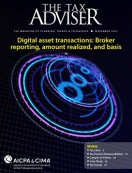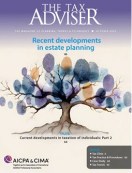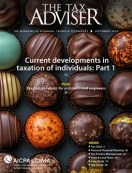- tax clinic
- partners & partnerships
Partnership recapitalization: Lender admittance without liability reduction
Related
PTEs need more notice of changes, more time to respond, AICPA says
Tax Court applies limited partner functional test for self-employment income
Final partnership adjustment not issued timely
Editor: Rochelle Hodes, J.D., LL.M.
Most lenders are understandably wary of holding operating assets or taking an equity position in a business; after all, they are lenders and have a different risk profile than the owners. However, if the equity value of the company is slightly above or below the debt balance and the business is struggling to meet its debt service, borrowers and lenders may engage in a process to restructure the existing debt so that a lender might agree to extend the loan term, loosen financial covenants, delay foreclosure, or change the way interest is paid, either by changing the interest rate or by accepting payment in kind.
A payment–in–kind arrangement could include offering the lender a stake in the business. In the case of a borrower that is a partnership, offering the lender an interest in the business comes with unique considerations and challenges. Not only does Subchapter K have to be considered, but the transaction could also trigger a recognition transaction under Sec. 1001. This item explores the tax consequences of a debt modification to the debtor in which the lender takes an equity position in the debtor partnership and there is no reduction in principal.
When a lender becomes a partner
For illustration purposes, the following facts will be used throughout this item:
Example 1: C and D, both individuals, are equal partners in Partnership A, a limited liability company (LLC) that is treated as a partnership for federal tax purposes. As of May 1, 2025, Partnership A’s books and records show a liability (representing a loan from Lender Y) with a tax and Sec. 704(b) basis of $110x.
Partnership A is struggling to meet its debt covenants, and based on the terms of the loan, Lender Y is currently in a position where it could exercise its right to foreclose on the debt. Partnership A asks Lender Y to consider a debt modification, and Lender Y agrees. Despite the fact that there is no formal valuation for Partnership A, all parties believe the value is somewhere around the value of the debt (including all unpaid interest).
During negotiations, Lender Y agrees to forgo its current foreclosure right and in exchange receives an 80% interest in future growth of the business. The agreement does not include a change in the amount of outstanding debt principal.
Your client, Partnership A, comes to you before the legal documents are drafted and asks about the potential tax consequences. What do you advise?
At first, you think that the 80% interest is a profits interest, but after further consideration, you are concerned that changes in the debt documents could be viewed as a material modification that rises to the level of “significant” under Regs. Sec. 1.1001–3(e), thereby triggering a taxable exchange of the old debt for the new debt.
Analysis under Sec. 1001
Under these facts, Lender Y’s receipt of an 80% interest (as inducement for not enforcing the right to foreclose) may be considered a consent fee. Generally, a consent fee paid in connection with a debt modification is treated as a yield adjustment that often rises to the level of a significant modification under Regs. Sec. 1.1001–3(e), triggering a taxable exchange of the old debt for the new debt, which could cause a potential income recognition event.
To the extent the revised adjusted issue price (taking into account the reduction due to the payment of the consent fee) is greater than the issue price of the new debt instrument (which also is reduced by the amount of the consent fee) the debtor recognizes cancellation–of–debt income (CODI). If the debt is “publicly traded” within the meaning of Regs. Sec. 1.1273–2(f), the issue price is generally the trading price of the debt on the date of the significant modification. Typically, in a distressed–debt situation such as this, the debt is trading at a discount (sometimes substantial) from its face amount. Accordingly, in such an instance, CODI arises in an amount equal to the difference between the adjusted issue price and the issue price of the new debt based on its trading price. This occurs notwithstanding that none of the principal of the debt has been reduced or adjusted.
Analysis under Subchapter K
In addition to testing the debt under Regs. Sec. 1.1001–3, the potential consequences under Subchapter K of receiving an interest in the debtor partnership should be considered. There is little coordination between Sec. 1001 and Subchapter K. Therefore, even if a determination has been made that a debt modification has occurred under Regs. Sec. 1.1001–3, the Subchapter K rules still must be analyzed.
Analyzing the consequences of the transaction under Subchapter K largely comes down to two considerations: (1) Does the modification or forbearance constitute property or a service, and (2) is the lender already a partner? Answering these questions may require making several inquiries, but the answers are necessary because they will affect the tax consequences of the transaction, as discussed below:
Is the forbearance property or a service? Answering this question requires considering the following additional criteria:
- Does Lender Y receive anything in liquidation if the business does not turn around?
- Is there an order of priority for distributions?
- Do the parties intend to assign a value to the interest received? The forbearance has value, but if the company is arguably underwater, can one argue that a receipt of a partnership interest has no value?
- Depending on the agreement between Lender Y and Partnership A, and whether the agreement is formalized in a written document and the terms of that document, Lender Y’s forbearance could be treated as a contract right. Regs. Sec. 1.721-1(a) indicates that “contractual rights” are considered property (see also Stafford, 727 F.2d 1043 (11th Cir. 1984)). However, if the agreement does not meaningfully modify Lender Y’s right to foreclose under the original debt instrument, the forbearance might not be treated as a contractual right but rather as a service.
The consequences of the determination of whether the forbearance is property or a service could be significant. If Lender Y’s forbearance is treated as a contribution of property, Sec. 721(a) applies regardless of whether the interest is a capital or profits interest. But, if Lender Y’s forbearance is a service rendered in exchange for a capital interest, Lender Y would be immediately taxed on an amount equal to the value of the forbearance (see Regs. Sec. 1.721–1(b)(1)). However, consider Regs. Sec. 1.721–1(d), which provides that Sec. 721 applies to a contribution of a partnership indebtedness by a creditor to the debtor partnership. Can a contribution of debt by the creditor be protected by Sec. 721 while a debt modification is not?
Is Lender Y already a partner? If the transaction is characterized as new equity (i.e., Lender Y is not already a partner), the classification of the liability as recourse or nonrecourse under Sec. 752 may change, resulting in deemed distributions under Sec. 752(b) that could generate gain to C and D under Sec. 731(a)(1). New equity could also trigger a minimum gain chargeback under Regs. Sec. 1.704–2(f). If Lender Y’s profit interest is reduced to 10% instead of 80%, the exception under Regs. Sec. 1.752–2(d) could apply, allowing Partnership A to continue classifying the liability as nonrecourse for Sec. 752 purposes. Meeting this exception could be difficult if partnership allocations are not all on a pro rata basis (i.e., target capital) or if the lender is unwilling to make a representation that they are a “qualified person” (see Secs. 465(b)(6) and 49(a)(1)(D)(iv)). Additionally, how the liability is allocated under Sec. 704(b) will likely dictate how losses are allocated (see Regs. Secs. 1.704–2 and 1.704–1(b)(3)).
In contrast, if Lender Y is already a partner, it may be possible to modify prospective allocations by recapitalizing the partnership using the principles discussed in Rev. Rul. 84–52. Also, if Lender Y already owns more than 10% of Partnership A or is not a “qualified person” under Sec. 752, the liability would have been treated as recourse for Sec. 752 purposes prior to the debt remodification, negating the impact of a shift in liabilities. A lender may also hold warrants or options with equity conversion features (see Regs. Secs. 1.721–2 and 1.761–3 to determine when and whether these could be considered equity for tax purposes).
Potential sale of partnership interests or assets
The first example presents significant areas of uncertainty, but tax advisers may find themselves addressing even more challenging considerations. If there is no equity value in the partnership and the lender is not protected by Sec. 721, then, arguably, there may be a sale of partnership interests for tax purposes under Sec. 741 from the existing partners to the lender. Going one step further illustrates the point well:
Example 2: Assume the same facts as the initial example, except that Lender Y’s interest needs to be in a newly formed entity. As such, Partnership A could form a new entity, New LLC. All of the operating assets, which are typically held by disregarded entities, are contributed to New LLC, with New LLC granting an interest to Lender Y. The new entity becomes a separately regarded partnership.
Under this analysis, some tax advisers would treat these facts as a sale of the assets under Rev. Rul. 99–5, Situation 1. Although the revenue ruling does not contemplate a cashless sale, it could apply. If the tax basis of Partnership A’s assets contributed to New LLC is greater than the debt balance, Partnership A could argue for sale/exchange treatment relying on the revenue ruling, resulting in a loss on the sale of the assets in exchange for the value (if any) of the forbearance. However, the IRS could take the position that Rev. Rul. 99–5, Situation 2, applies instead. In this case, the IRS would treat the transaction as if A had contributed the assets to New LLC under Sec. 721(a) and disallow the loss (query whether the loss could also be disallowed under the related–party rules of Sec. 707, depending upon ownership in both partnerships).
Another issue relates to how much of the property is deemed transferred to Lender Y. In the original fact pattern, Lender Y is given an 80% interest in Partnership A. However, it is unclear what that actually means. If the parties are correct that the value of Partnership A is truly equal to the outstanding debt on the date the debt is modified, Partnership A could be treated as having effectively sold 100% of its assets upon the issuance of equity to Lender Y. After all, a deemed liquidation of the new partnership immediately after the transaction would result in Lender Y only getting back the previous debt balance. In a sale, presumably, tracking liabilities and minimum gain could become irrelevant, as the taxable sale would override those considerations. Alternatively, if the transaction is covered by Rev. Rul. 99–5, Situation 2, the previously discussed Sec. 752(b) and Regs. Sec. 1.704–2 considerations would apply.
Mulling debt modification
In the current environment of economic uncertainty and high interest rates, tax advisers will continue to see unique debt restructuring negotiations that have the potential to raise substantial tax uncertainty. It is critical in these situations to understand the specifics of the transactions by reviewing the underlying documentation and considering the economic arrangement of the parties. Parties entering debt modification negotiations should consider their tax goals and the potential tax consequences of the form of the modification proactively during negotiations to achieve the desired result and not be surprised by unintended tax consequences. Taxpayers should engage a tax adviser to assist in evaluating debt modification proposals, even when the principal of the debt is not being modified.
Editor
Rochelle Hodes, J.D., LL.M., is principal with Washington National Tax, Crowe LLP, in Washington, D.C.
For additional information about these items, contact Hodes at Rochelle.Hodes@crowe.com.
Contributors are members of or associated with Crowe LLP.














